Measure Descriptions for Daily Care Processes: Facilitator Guide
AHRQ Safety Program for Mechanically Ventilated Patients
Slide 1: Measure Descriptions for Daily Care Processes
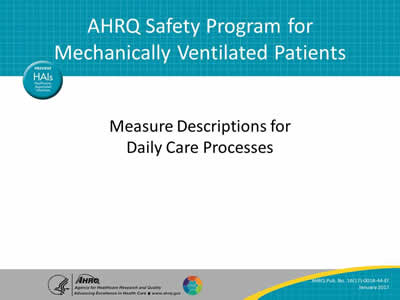
Slide 2: Learning Objectives
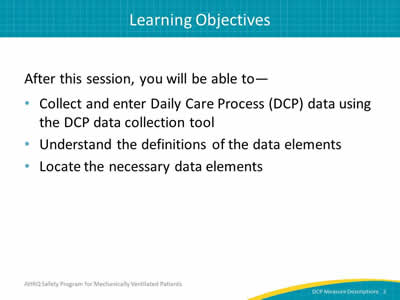
Slide 3: Daily Care Processes: Key Interventions
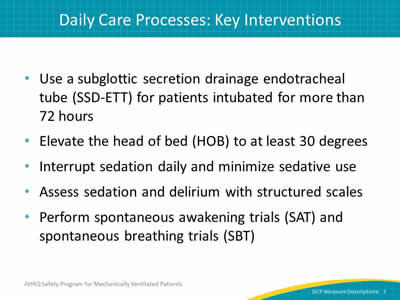
Ask: What are some of the key interventions of daily care processes?
Say: Patients who are intubated for more than 72 hours should have a subglottic secretion drainage endotracheal tube (SSD-ETT). In addition, the head of the bed (HOB) should be elevated to no less than 30 degrees. Be sure to interrupt sedation on a daily basis and minimize sedative use. You can assess sedation and delirium levels by using structured scales. Finally, performing spontaneous awakening trials (SATs) and spontaneous breathing trials (SBTs) will help assess if a patient still requires mechanical ventilation or can be taken off of the ventilator.
Slide 4: Data Collection
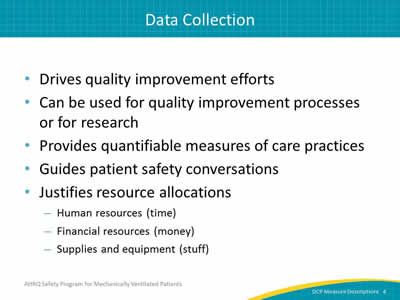
Ask: Why is collecting data important?
Slide 5: Daily Care Processes Data Collection Tool
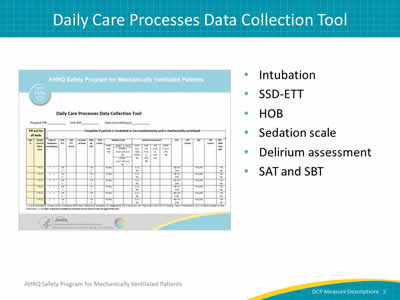
Say: The Daily Early Mobility Collection Tool is a resource you can use to collect information on your early mobility measures. It includes information about when the patient was intubated, which sedation scale your unit uses, and the results of sedation scales performed. It also logs which delirium assessment scale your unit uses and the results of those assessments, the highest level of your patients’ mobility and perceived barriers to meeting a higher level of mobility, whether your patients were evaluated by a physical or occupational therapist, and finally, whether any adverse events associated with mobilization occurred and, if not, what types of events occurred.
Slide 6: Data Collection: Intubation, SDD-ETT, and HOB
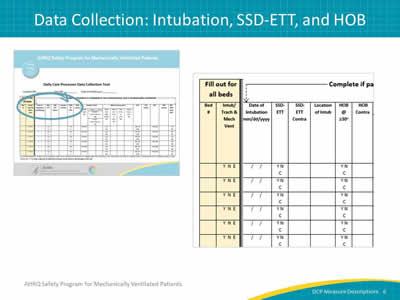
Say: Here you can see examples of the DCP data collection tool and where you can input data on patient intubation, SSD-ETT, and HOB.
Slide 7: Let’s Begin…
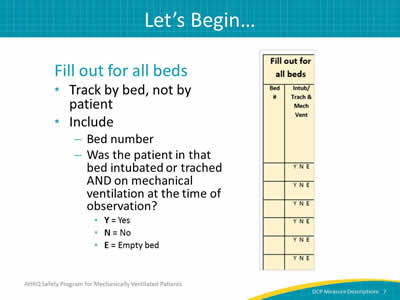
Say: The Early Mobility measures are tracked by bed and not by a specific patient. It is most useful to track all beds in the unit, whether they are filled or not. Begin by filling out the bed number and whether the patient in that bed was intubated or has received a tracheostomy (trached) AND on mechanical ventilation at the time of observation. The codes you will use are listed on the collection tool itself: use the "Y" code if the patient is intubated or trached AND on mechanical ventilation, use the "N" code if the patient is NOT, and use "E" if the bed is empty.
Slide 8: Date of Intubation
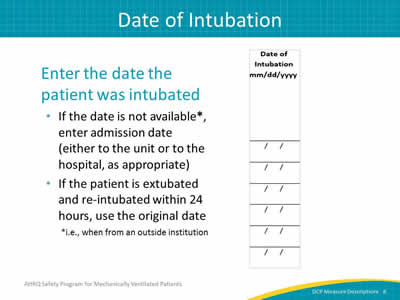
Say: The next field is the date of intubation. In this field, you enter the date that the patient was intubated.
Ask: What if that information is not available, such as when a patient is transferred from an outside institution?
Say: If that date is not available, enter the admission date to either the unit or the hospital as appropriate.
Ask: What if the patient has been extubated and reintubated? Which date should be used?
Say: If the patient has been extubated and reintubated within the previous 24 hours, then use the date of the original intubation.
Slide 9: SSD-ETT
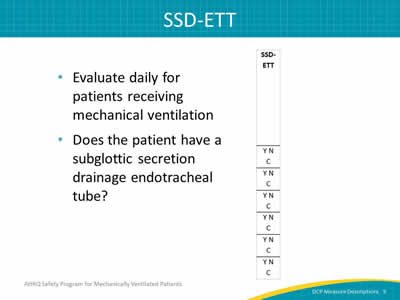
Say: Use the SSD-ETT field daily to evaluate patients receiving mechanical ventilation.
Ask: Does the patient have a subglottic secretion drainage endotracheal tube?
Slide 10: SSD-ETT
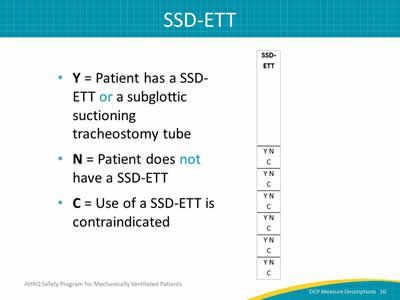
Say: Enter "Y" for "yes," the patient has a SSD-ETT or a subglottic suctioning tracheostomy tube. Enter "N" for "no," the patient does not have a SSD-ETT. Enter "C" to indicate that the use of a SSD-ETT is contraindicated.
Slide 11: SSD-ETT Contraindications
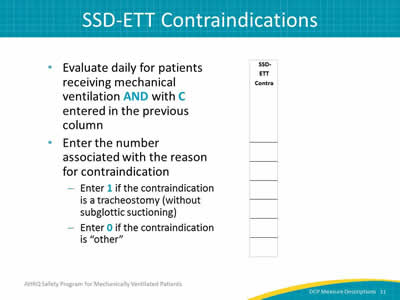
Say: During your daily patient evaluations, check for patients that are both receiving mechanical ventilation and who have "C" entered in the previous column for "contraindication." Enter the number associated with the reason for contraindication. There are two numbers to choose from: 1 and 0. Enter 1 if the contraindication is a tracheostomy, without subglottic suctioning. Entering 0 indicates "other."
Slide 12: Location of Intubation
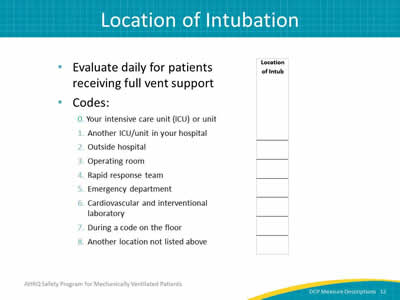
Say: When performing a daily evaluation of patients receiving full vent support, you will use one of eight different codes to indicate the location of each patient’s intubation. Use 0 if the patient was intubated in your intensive care unit (ICU) or hospital, 1 is attributed to another ICU or unit in your hospital, 2 refers to an outside hospital, 3 refers to the operating room, 4 to a rapid response team, 5 to the emergency department, 6 to the cardiovascular and interventional laboratory, 7 is used for placement during a code on the floor, and 8 indicates another location not previously listed.
Slide 13: HOB ≥ 30 Degrees
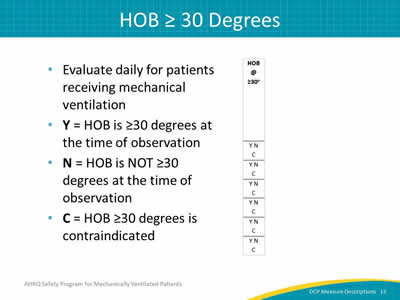
Say: As you would do for intubation and SSD-ETT, evaluate HOB daily for patients receiving mechanical ventilation. Entering "Y" indicates that HOB is elevated at least 30 degrees at the time of observation. Entering "N" indicates that HOB is not elevated at least 30 degrees at the time of observation. Entering "C" indicates that HOB elevation of at least 30 degrees is contraindicated.
Slide 14: HOB Elevation Contraindications
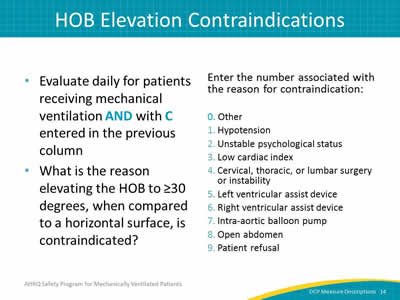
Say: During your daily patient evaluations, check for patients who are both receiving mechanical ventilation and who have "C" entered in the previous column for "contraindication."
Ask: What is the reason elevating the HOB to at least 30 degrees, when compared to a horizontal surface, is contraindicated?
Say: Enter the number associated with the reason for contraindication. There are 10 numbers to choose from. Zero indicates "other," 1 refers to hypotension, 2 to unstable psychological status, 3 to low cardiac index, 4 to cervical, thoracic, or lumbar surgery or instability, 5 to left ventricular assist device, 6 to right ventricular assist device, 7 to intra-aortic balloon pump, 8 to open abdomen, and 9 to patient refusal.
Slide 15: Data Collection: Sedation and Delirium
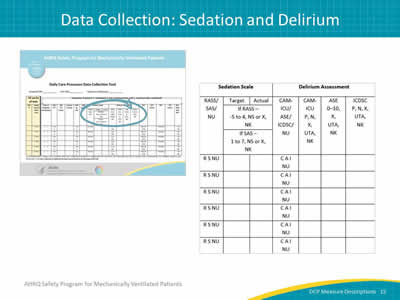
Say: Here’s another look at the DCP data collection tool that you can use to enter sedation and delirium assessment data.
Slide 16: Sedation Scale
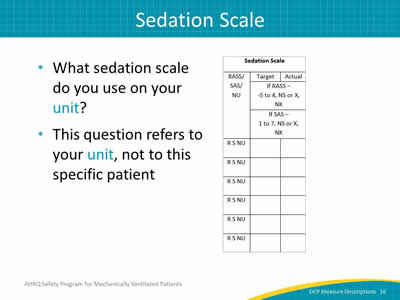
Ask: What sedation scale do you use in your unit?
Say: This question refers to your unit, not to a specific patient in the bed being observed. For your unit, you would indicate whether you use a Richmond Agitation Sedation Scale (RASS), a Riker Sedation-Agitation Scale (SAS), or no sedation scale at all.
Slide 17: Sedation Scale
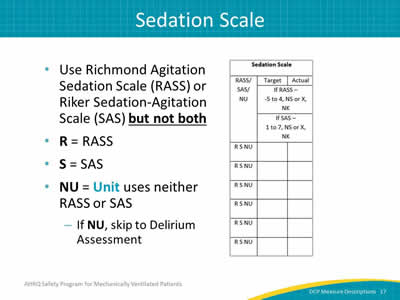
Say: While the majority of units will likely use either the RASS or the SAS, some units may not employ either of these scales or do not use a sedation scale at all. If you're using neither the RASS nor the SASS, enter the code "NU" for "Not Used" and move on to the field for Delirium Assessment.
For units that do employ either RASS or SASS, select which scale. You can choose between RASS or SAS, but you cannot choose both.
Slide 18: Sedation Scale: Target RASS
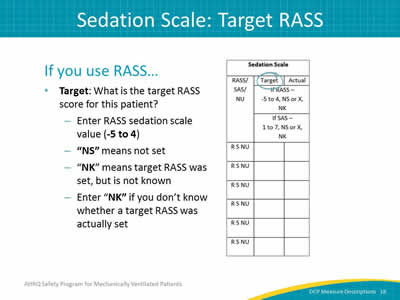
Ask: If you use RASS in your unit, what is the target RASS score for an individual patient?
Say: First, enter the RASS sedation scale value. This value will range from negative 5 to positive 4. Entering "NS"” instead indicates that the target was not set.
Ask: What if the Target RASS score is unknown?
Say: There are two scenarios where you will choose "NK," for "not known." The first is if you know the target was set but you do not know the target value. Perhaps it was set by a coworker but you have no way of finding out what it is. The other scenario is if you do not know whether a target RASS score was set. Based on the Joint Commission’s recommendations, the target RASS score must be set by a physician. However, as improving care for these patients involves an interdisciplinary approach, consider suggesting that a physician write the order for your target RASS, but encourage team members to discuss what they feel would be an appropriate RASS score. This conversation could typically take place during rounds.
Slide 19: Sedation Scale: Actual RASS

Ask: What is the actual RASS for this patient?
Say: Once again, enter the RASS sedation scale value, between negative 5 and positive 4. Entering "X" instead indicates that that an actual RASS sedation level was not scored while entering "NK" indicates that the target RASS was scored, but is not known. Always enter "NK" if you’re unsure of whether a target RASS was actually set or not.
Slide 20: Sedation Scale: Target SAS
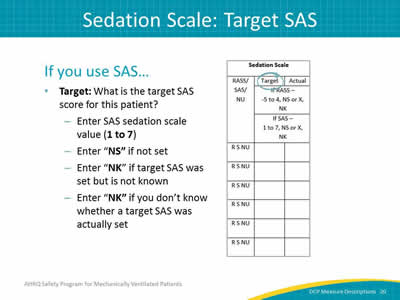
Ask: What is the target SAS for this patient?
Say: Enter the SAS sedation scale value, between 1 and 7. If the target SAS is not set, enter "NS." If the target SAS is set but is not known, enter "NK." Always enter "NK" if you’re unsure of whether a target SAS was actually set or not.
Slide 21: Sedation Scale: Actual SAS
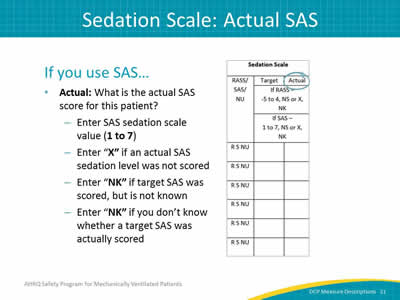
Aslk: What is the actual SAS score for this patient?
Say: Just as you would do for the target SAS, enter the SAS sedation scale value. If an actual SAS sedation level was not scored, enter "X." Once again, enter "NK" if the target SAS was scored but is not known.
Slide 22: Sedation Scale: NU
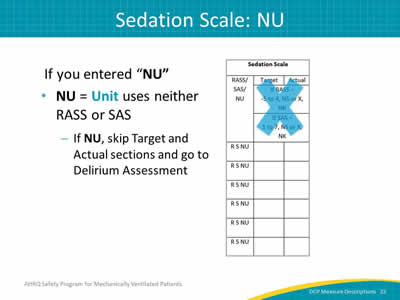
Say: If you choose "NU" because your unit implements neither the RASS nor SAS, you will skip the target and actual RASS or SAS scores and go directly to the Delirium Assessment column.
Slide 23: Delirium Assessment
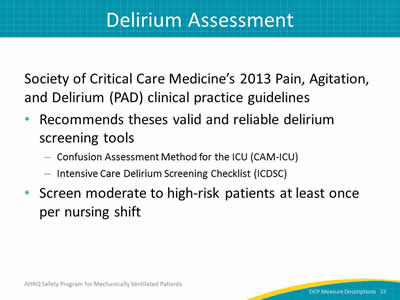
Say: The Society of Critical Care Medicine’s 2013 Pain, Agitation, and Delirium (PAD) clinical practice guidelines recommend the Confusion Assessment Method for the ICU (CAM-ICU) and the Intensive Care Delirium Screening Checklist (ICDSC) as valid and reliable delirium screening tools. You should use these tools to screen moderate to high risk patients at least once per nursing shift.
Slide 24: Delirium Assessment
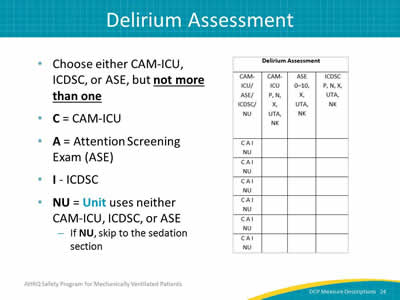
Say: To complete the Delirium Assessment, you will have to enter the screening tool used in your unit. Enter "C" to indicate use of the CAM-ICU, "A" for the Attention Screening Exam (ASE), "I" for the ICDSC, or "NU" if your unit didn’t use any of the aforementioned. If you enter "NU," skip directly to the sedation section. Only pick one screening instrument to record.
Slide 25: Delirium Assessment: CAM-ICU
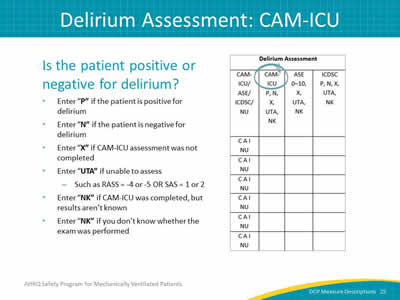
Say: Now, let’s review how to complete these fields if the CAM-ICU or ICDSC is used to assess for delirium. In this column, you will indicate whether the patient was positive or negative for delirium according to the assessment. If the patient is positive, use the "P" code. If the patient is negative, use the “N” code. If you know a delirium assessment was not conducted, use the "X" code.
Ask: What if the patient is heavily sedated and cannot be assessed?
Say: If you're unable to assess delirium because the patient is heavily sedated, then you will put in "UTA." For example, if the patient has a RASS score of negative 5 or 4, or a SAS of 1 or 2, that would be the only time where you would use this "UTA."
Ask: What if the outcome of the assessment is unknown or if it’s unknown whether the assessment was completed in the first place?
Say: If you do not know the results of the screening, or if you do not know whether the exam was performed, use the code "NK" to document "not known."
This data field records whether or not the patient is positive or negative for delirium. Again, you will first need to indicate which assessment was used. You cannot choose both the CAM-ICU and ASE, you must choose one or the other. This is because the ASE is incorporated into the CAM-ICU, therefore, if the CAM-ICU is used, the ASE is also completed by default. However, the ASE can be completed independently of the CAM-ICU.
Slide 26: Delirium Assessment: ICDSC
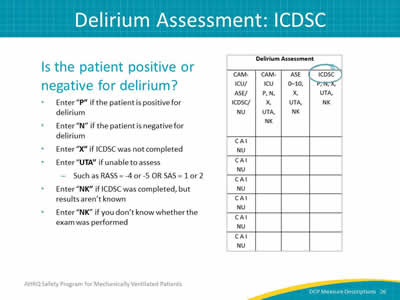
Say: These fields should be completed identically to the fields for CAM-ICU. In this column, you will indicate whether the patient was positive or negative for delirium according to the assessment. If the patient is positive, use the "P" code. If the patient is negative, use the "N" code. If you know a delirium assessment was not conducted, use the "X" code.
Slide 27: Delirium Assessment: Attention Screening Exam
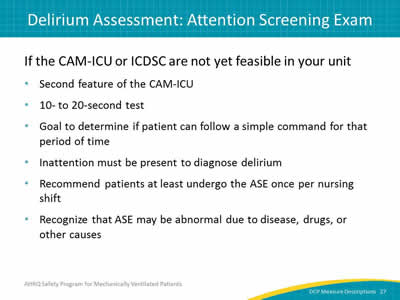
Ask: What should you do if neither the CAM-ICU nor the ICDSC are feasible in your unit?
Say: If you cannot do the CAM-ICU or ICDSC on your unit or if providers feel it is too time consuming, consider using just the ASE component once per shift. The ASE is actually a part of the CAM-ICU and takes just 10 to 20 seconds to complete. This assessment addresses an important feature for a delirium diagnosis, inattention, by determining if a patient is able to follow a simple command for 20 seconds. It’s important to recognize that the ASE may be abnormal due to disease, drugs, or other causes.
Slide 28: Attention Screening Exam
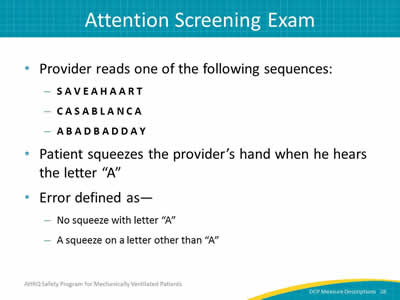
Say: The Attention Screening Exam, as mentioned previously, determines if a patient can pay attention and follow a simple command for 10 to 20 seconds. Inattention is a cardinal feature of delirium for diagnosis and the ASE provides a good barometer of the presence or absence of delirium.
Ask: How is the ASE conducted?
Say: To conduct the ASE, the provider reads one of the letter sequences shown on this slide. Read the sequence to the patient letter by letter. The patient is asked to squeeze the provider’s hand every time they hear the letter "A," and the provider will count the number of errors made. For example, if the patient does not squeeze on an "A," then that would be an error. If a patient squeezes on a letter other than an "A," that would also be an error.
Slide 29: Attention Screening Exam
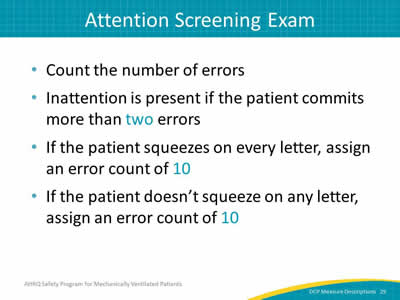
Say: Inattention is considered to be present if the patient commits more than two errors. To determine the number of errors, count the number of times the patient does not squeeze when the letter "A" is spoken or if the patient squeezes on a letter that is not "A." If the patient squeezes for every letter, assign an error count of 10 (even though they did squeeze correctly when the letter "A" was spoken), and if the patient doesn’t squeeze on ANY letter, an error count of 10 would be assigned then as well.
Slide 30: Attention Screening Exam
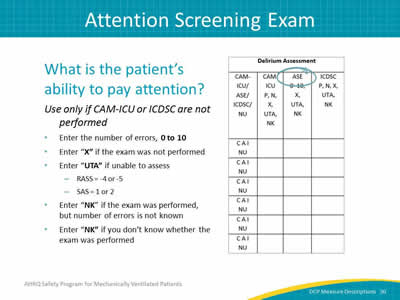
Ask: What is the patient’s ability to pay attention?
Say: In the ASE column, record the number of errors counted during the assessment. Mark "X" if the ASE was not completed as a standalone assessment. If your patient is considered to be highly sedated, defined as having a negative 5 or negative 4 RASS or a SAS of 1 or 2, you would use "UTA," or Unable to Assess. If the ASE was not performed, you do now know whether it was performed at all, or if you do not know the number of errors, use the code "NK" for not known. Remember: only use the column for the ASE if the CAM-ICU was NOT performed.
Slide 31: Data Collection: SAT and SBT
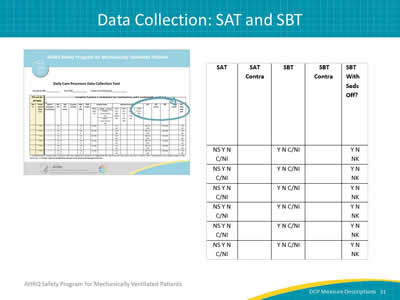
Say: This slide shows the DCP data collection tools used for SATs and SBTs.
Slide 32: Spontaneous Awaking Trial
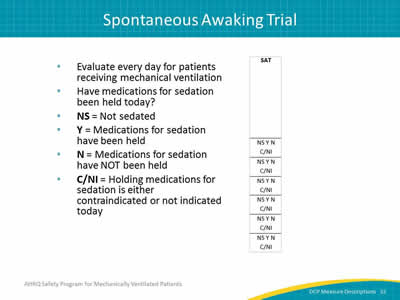
Say: When performing an SAT, evaluate patients receiving mechanical ventilation every day. Have medications for sedation been held today? If so, enter "Y" to say that yes, medications for sedation have been held. If not, enter "N." If the patient has not been sedated, enter "NS." If holding medications for sedation is either contraindicated or not indicated on that day, enter "C/NI."
Slide 33: SAT—Contraindications
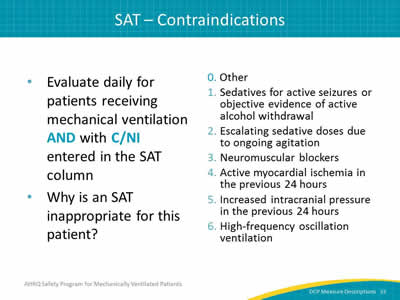
Say: SAT Contraindications: Evaluate daily for patients receiving mechanical ventilation AND with C/NI entered in the SAT column of the data collection tool.
Ask: Why is an SAT inappropriate for this patient?
Say: Enter the number corresponding with the applicable reason. Zero is for other, 1 is for sedatives for active seizures or objective evidence of active alcohol withdrawal, 2 is for escalating sedative doses due to ongoing agitation, 3 is for neuromuscular blockers, 4 is from active myocardial ischemia in the previous 24 hours, 5 is from increased intracranial pressure in the previous 24 hours, and 6 is from high-frequency oscillation ventilation.
Slide 34: Spontaneous Breathing Trial
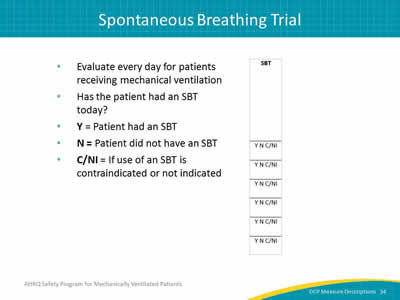
Say: When performing an SBT, evaluate patients receiving mechanical ventilation every day just as you would for an SAT. Has the patient had an SBT today? If so, enter "Y." If not, enter "N." Enter "C/NI" if the use of an SBT is contraindicated or if it’s not indicated.
Slide 35: SBT—Contraindications
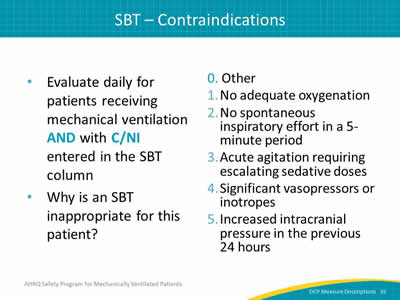
Say: SBT Contraindications: Evaluate daily for patients receiving mechanical ventilation AND with "C/NI" entered in the SBT column of the data collection tool.
Ask: Why is an SBT inappropriate for this patient?
Say: Enter the number corresponding with the applicable reason. Zero is for other, 1 is for no adequate oxygenation, 2 is for no spontaneous inspiratory effort in a 5-minute period, 3 is for acute agitation requiring escalating sedative doses, 4 is for significant vasopressors or inotropes, and 5 is for increased intracranial pressure in the previous 24 hours.
Slide 36: SBT—With Sedatives Off
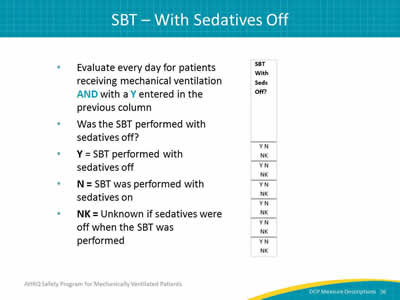
Say: SBT with sedatives off: Evaluate daily for patients receiving mechanical ventilation AND with a "Y" entered in the previous column of the data collection tool. Was the SBT performed with sedatives off? If so, enter "Y." If not, enter "N." If unknown, enter "NK."
Slide 37: Data Measures Guide
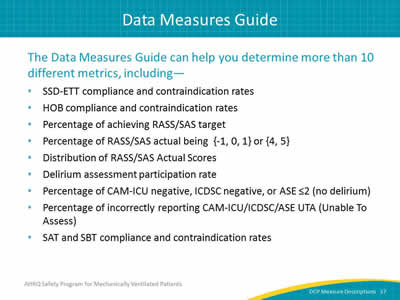
Ask: How can we use the data we collect?
Say: The Data Measures Guide provides detailed explanations for the measures used to evaluate the implementation of the interventions within the AHRQ Safety Program for Mechanical Ventilation. It gives you a foundation for evaluating both process and outcome measures in your unit or hospital by providing detailed instructions and guidance on calculating metrics you can use to improve the safety of your patients. From the information recorded on the Daily Early Mobility Collection Tool, you can use the Data Measures Guide to find out more than ten different metrics, including your delirium assessment participation rate, the percentage of patients achieving their RASS or SAS target, and determine the top ten adverse events for ventilated and nonventilated patients.
Slide 38: Data Measures Guide
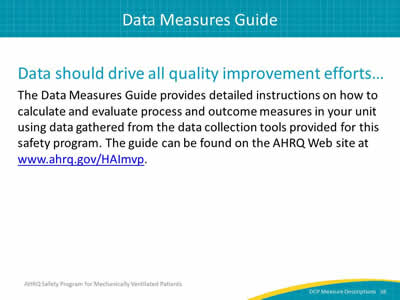
Say: We know that data should drive all quality improvement efforts, and so the Data Measures Guide is a very helpful tool to have when calculating and evaluating the outcome measures in your unit. The guide can be found on AHRQ’s Web site.
Slide 39: Questions?
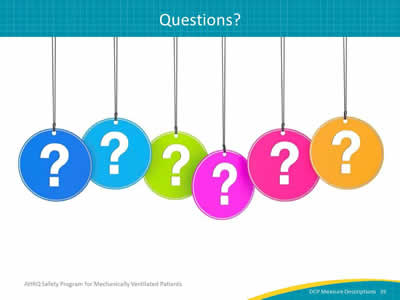
Ask: Are there any questions?



